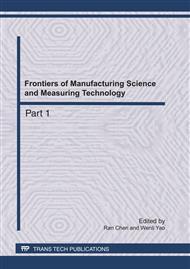[1]
G. Chen, et al: Information of Inertial Switch, Information and Electricity, Vol. 7(5), 439-442 (2009), in Chinese.
Google Scholar
[2]
R. Pvan Kampen, R. F. Wolffenbuttel: Modeling the Mechanical Behavior of Bulk-micro Machined Silicon Accelerometers, Sensors and Actuators A, Vol. 64(1), pp.137-150 (1998).
DOI: 10.1016/s0924-4247(98)80007-1
Google Scholar
[3]
J. Tsay, L. Q. Su and C. K. Sung: Design of a Linear Micro-feeding System Featuring Bistable Mechanics, J. Micromech. Microeng, Vol. 15 (1), pp.63-70(2005).
DOI: 10.1088/0960-1317/15/1/010
Google Scholar
[4]
C. N. Oguibe, S. H. Mannan, D. C. Whalley, et a1, Conduction Mechanisms in Anisotropic Conducting Adhesive Assembly, IEEE Transactions on Components Packaging Technologies, Manufacturing Technology, part A, Vol. 21(2), pp.235-242(1998).
DOI: 10.1109/95.705469
Google Scholar
[5]
Y. Fu, M. Willanter and J. Liu: Statistics of Electric Conductance through Anisotropically Conductive Adhesive, IEEE Transactions on Components and Packaging Technologies, Vol. 24(2), pp.250-255(2001).
DOI: 10.1109/6144.926390
Google Scholar
[6]
Tilmans H. A.: Micro Resonant Force Gauges, Sensors and Actuators A, pp. Vol. 30(1), 35-539(1992).
Google Scholar
[7]
Jian Zhao, Jianyuan Jia, Hongxi Wang andYanjie Gou: A V-shaped Beam Structure of the Bistable Inertia Switch, Aeronautics, Vol. 29 (5) , 1157-1162, (2008), in Chinese.
Google Scholar
[8]
Hu Jun, Yang Bo: Vibration Resistance Design to Improve the Acceleration, Sensors and Micro Systems, Vol. 26 (2), pp.56-57(2007), in Chinese.
Google Scholar
[9]
Yingmin Zhu, Jianyuan Jia, Hongqi Fan: The Air Damping of Dreadmill Exercise for MEMS Devices, Journal of Xidian University, Vol. 36 (5), 965-968, (2007), in Chinese.
Google Scholar
[10]
Wenchao Tian, Huorong Ren, Linbin Wang and Huanling Liu: Sticking Analysis of the Bistable Inductive Micro-switch, Advanced Materials Research, pp.97-101: 2876-2879(2010).
DOI: 10.4028/www.scientific.net/amr.97-101.2876
Google Scholar
[11]
Wenchao Tian, Linbin Wang, Jianyuan Jia, Csimir forces: Hamaker Rorce and Research of Adhesion snap back, Physics, Vol. 59 (2), 1182-1186(2010), in Chinese.
Google Scholar
[12]
Wenchao Tian, Jianyuan Jia: Winger-Seitz Model of Micro-continuity, Physics, Vol. 58 (9), 5930-5935( 2009), in Chinese.
Google Scholar
[13]
Yubao Zhang, Qiang Li: COMSOL Multiphysics MEMS-based MEMS-based and Application, (2007, in press), in Chinese.
Google Scholar


